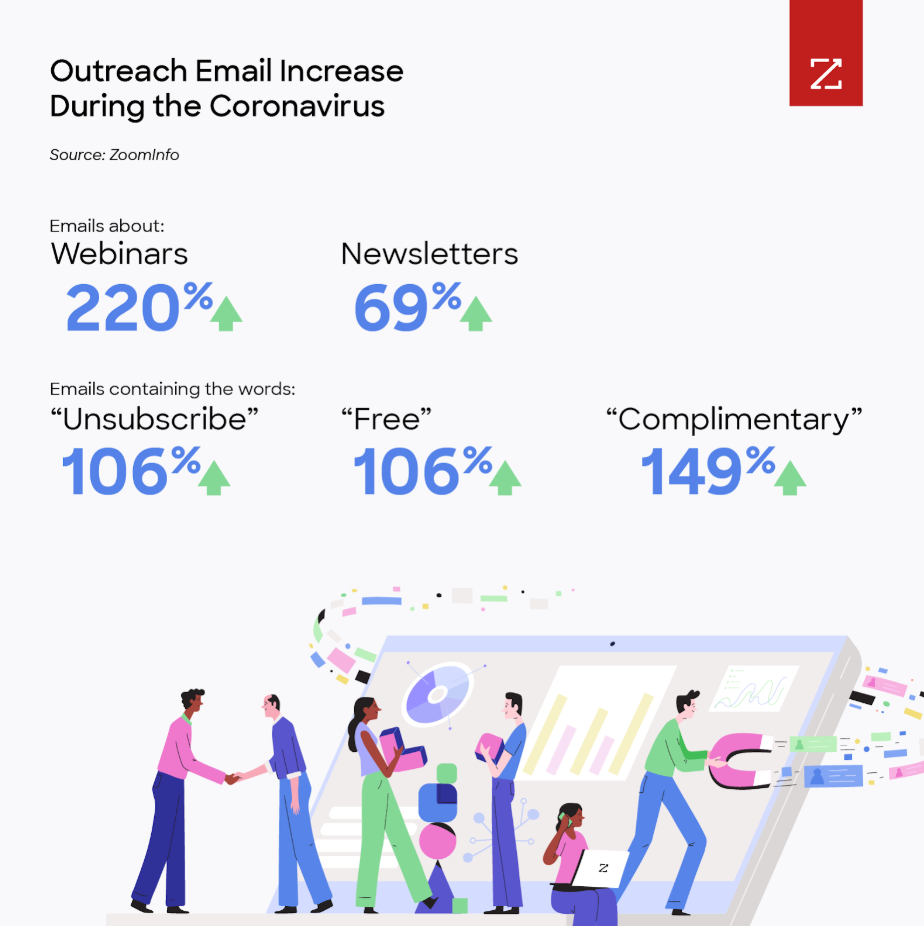Like it or not, COVID-19 has forced businesses to adapt.
Video conferencing and cloud-based technologies are seeing a massive uptick in usage since mid-March. As companies do what needs to be done to survive, they turn to solutions they’ve never used before. There’s one thing that you may not have yet realized is gaining in popularity as a result of the pandemic: outbound sales and marketing.
Companies around the world are building and using “muscles,” or capabilities they’ve never had. And in most cases, these capabilities are not going to go back into hibernation when the COVID-19 crisis is over. In many industries, COVID-19 has acted as an accelerator requiring organizations to get better at their weaknesses, and to get better at them fast.
This led me to start thinking about what other “muscles” are being worked during COVID-19. In the B2B world, there are some fairly obvious ones that we’ve read about like virtual events, remote training, and better attention to employee mental health.
So here’s how I decided to dig deeper to see if I was on the right path. With the approval of our CEO and the help of our IT team, I began querying our internal email traffic logs to get counts of certain types of messages to get to the bottom of this.
First test: how many incoming emails did ZoomInfo receive in February versus April? In February, we received just over 42,000 external emails per day. In April? Over 53,000. That’s an increase of over 25%.
As a sanity check, I did some research on this issue. I found that Hubspot has been tracking this pretty well in their blog. What did they find? Marketing emails are up 20% and sales emails are up 50% compared to their pre-COVID-19 levels!
So my suspicions were confirmed. Email traffic is up. Marketing emails are up. Sales emails are way up. But I wasn’t satisfied. Why? Because it doesn’t feel like I’m getting 25% or 50% more cold outreach. It feels like more. I suspect that it’s because in my role as SVP of Innovation and Data R&D, I don’t really interact with too many external email addresses.
A Pandemic of Outreach Email
How did I get here? Well, I’ve been noticing something every time I boot up my computer, from my home office, during the COVID-19 crisis. It’s noticeable. And I bet when I say what it is, you’re going to nod your head in agreement that you’re seeing it too. I’m getting much more email than I ever have before.
That morning routine of archiving emails has morphed from a 30-second task to a chore. And the types of emails are different than they’d use to be. More webinars, that makes sense. But I’m also getting more cold outreach. Newsletters I didn’t register for, promotional offers, meeting requests, I’m seeing an influx.
And I’d ask my friends, are you noticing this? They’d confirm my suspicions. I started thinking: is cold outreach (outbound sales and marketing) one of these muscles that companies are being forced to build?
A long time ago I used to work in marketing at DiscoverOrg before it was called ZoomInfo. I learned that outbound marketing is an art, it’s not a science. The core competencies you need to do to be really successful are intimidating, whether it’s having the right tech stack, minimizing bounces, preserving your domain’s reputation, or crafting messages that yield engagement.
For many small and medium-sized businesses, cold outreach is something they’ve historically shied away from either due to false impressions about the popularity of cold outreach or a lack of knowledge about how to make it work. And so my theory was that perhaps companies are starting to build up this cold outreach muscle, not by choice, but by necessity.
Measuring Outreach Email During the Coronavirus
As I previewed a bit earlier, my first approach was to compare email messages delivered to ZoomInfo users both in February and April. February was the last month where businesses were unaffected by COVID-19. April was the first full month post COVID-19 hysteria. Comparing February to April seemed like a pretty good barometer. If I’m right, we should see significantly more cold outreach in April than February.
So I started really digging into determining the degree of the increase of certain types of emails:
Incoming emails about Webinars: Up 220%
Incoming newsletters: Up 69%
What about emails sending me offers?
Emails with the word “complimentary”: Up 149%
Emails with the word “free” Up 106%
What about just pure marketing emails?
Emails with the word “unsubscribe” in them up 106%
Emails with the word “email preferences” in them up 82%

Are Companies Doing More Cold Outreach During the Pandemic?
And then we finally get to the point I’ve been trying to prove this entire time: We know that companies are using webinars more with in-person events on hold. We know that companies are going to try and reach customers more often with newsletters or promotions.
But the real question that may not be intuitive is this: “Are people turning to outbound or “cold” sales emails more often in a post COVID-19 world?”
My query looked for the frequency of phrases most commonly used in outbound emails in first message emails (no replies or forwards) from external domains to ZoomInfo. I consulted ZoomInfo’s outbound demand generation experts to compile a list of the most common (and least creative) phrases used in outbound emails.
Guess what we found?
We found that messages with classic outbound phrases like “time to connect”, “I am reaching out”, “who is the right person?”, and many more are up 130%!
That’s right, we’re seeing significantly more than double the cold sales emails in our collective inboxes at ZoomInfo.
Final Thoughts on Sales & Marketing Outreach During COVID-19
There it is. Sure, we’re only using one company’s incoming emails, but we’ve got over 1300 inboxes receiving email every day. That’s a pretty good sample size.
The data have always shown that cold outreach is a very important component of successful sales and marketing campaigns. Yet a good percentage of companies were holding back. It appears the threat of COVID-19 on the livelihood of small and medium businesses has forced the teams responsible for revenue generation to take the training wheels off their campaigns.
Every dollar matters when it comes down to hitting their number, and they’re finally tapping into a revenue stream that was sitting there the whole time.


